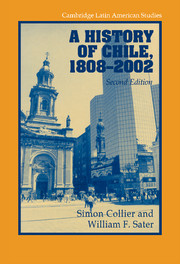Book contents
- Frontmatter
- Contents
- List of maps
- Preface to the Second Edition
- A note on geography
- CAMBRIDGE LATIN AMERICAN STUDIES
- PART I Birth of a nation-state, 1800s–1830s
- 1 Colonial foundations, 1540–1810
- 2 Independence, 1808–30
- 3 The conservative settlement, 1830–41
- PART II The rise of a republic, 1830s–1880s
- PART III The nitrate era, 1880s–1930s
- PART IV Industrial advance and the dawn of mass politics, 1930s–1960s
- PART V Democracy and dictatorship, 1960s–2000s
- Glossary of Spanish terms
- Initials and acronyms
- Further reading
- Index
3 - The conservative settlement, 1830–41
Published online by Cambridge University Press: 05 June 2012
- Frontmatter
- Contents
- List of maps
- Preface to the Second Edition
- A note on geography
- CAMBRIDGE LATIN AMERICAN STUDIES
- PART I Birth of a nation-state, 1800s–1830s
- 1 Colonial foundations, 1540–1810
- 2 Independence, 1808–30
- 3 The conservative settlement, 1830–41
- PART II The rise of a republic, 1830s–1880s
- PART III The nitrate era, 1880s–1930s
- PART IV Industrial advance and the dawn of mass politics, 1930s–1960s
- PART V Democracy and dictatorship, 1960s–2000s
- Glossary of Spanish terms
- Initials and acronyms
- Further reading
- Index
Summary
If one day I took up a stick and gave tranquillity to the country it was only so that the bastards and whores of Santiago would let me get on with my work in peace.
– Diego Portales (1831)The Conservative coalition that took power in 1830 was the first of three successive political combinations that governed Chile over the next six decades. Its twenty-seven-year lease on power helped lay the foundations of a tradition of political stability unique in nineteenth-century Spanish America – where mutinous armies, caudillo dictatorships, palace revolutions, and civil wars were constant and commonplace. Thanks to this tradition, as Tulio Halperín has observed, Chile came to enjoy “unrivalled political prestige among the Spanish American republics.”
There was nothing inevitable about this. Chile's unusual tradition was created by Chileans, not gods. Yet the ex-colony did possess certain built-in advantages from the viewpoint of consolidating a viable nation-state, and, at the risk of recrossing ground already covered, it is worth reminding ourselves of some of them. Post-colonial Chile was a compact, manageable land, with no more than 700 miles separating the northern limit of settlement from the Araucanian Frontier along the Bío Bío, and with the bulk of the population concentrated in the northern Central Valley. The settlements farther south, around Valdivia and on the island of Chiloé, were unimportant appendages of the new republic, as was (to look ahead a bit) the penal colony established on the Magellan Straits after 1843, partly to confirm the Chilean claim to the area.
- Type
- Chapter
- Information
- A History of Chile, 1808–2002 , pp. 51 - 70Publisher: Cambridge University PressPrint publication year: 2004



